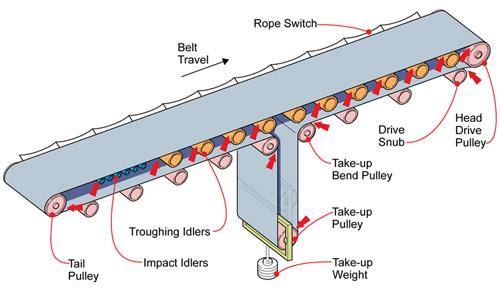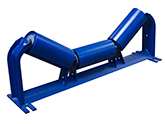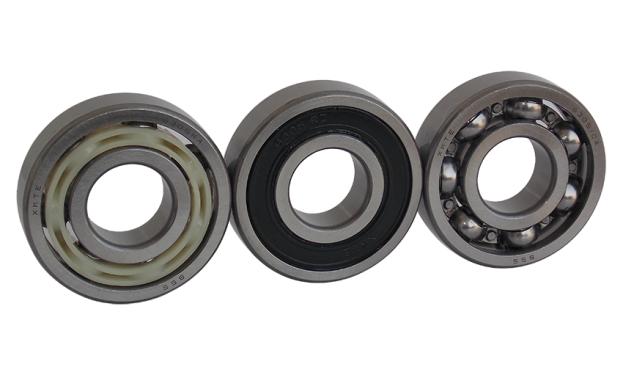Troughing idler, which is the most common idlers used on belt conveyor, is mounted on the carrying side, used for conveying bulk materials. Generally it consists of 3 rollers in equal length. The two outer rollers are inclined upward and the middle one is horizontal. The inclined degree can be 30°,35°and 45°, some can be up to 60° in suspended type. There are two basic types: standard type and ahead inclined type. The latter can also be present all through the conveyor to prevent the belt from sideslip.
A Troughing Idler is comprised of a central idler roll, which has a fixed width, and two or more wing idlers located on each side of the central idler roll. The wing idlers can be adjusted up or down to change the toughing angle, which affects the depth of the trough created by the conveyor belt as it moves.
The troughing idlers comprise a centre idler roll of a defined width, and 'wing' idlers on either side of the centre roll. Unlike the centre, horizontal roll, the wing idlers are cranked up to an angle known as the troughing angle. This troughing angle ensures that the carrying belt maintains the same cross-sectional area throughout the carrying strand, so that the load-bearing capacity of a particular conveyor belt is the same along the conveyors' full length. In so doing, material loaded to the maximum capacity at the loading point will not fall off of the belt en-route.
Diameter idler mm
Length (tube) mm
Bearing
89
180.190.200.235.240.250.275.280.305.215.350.375.380.455.465.600.750.950.1150
204
108
190.200.240.250.305.315.360.375.380.455.465.525.530.600.700.750.790.800.950.1150.1400.1600
6204 6205 6305 6306
133
305.375.380.455.465.525.530.600.670.700.750.790.800.900.950.1000.1100.1150.1400.1600.1800.2000.2200
6205 6305 6306
159
375.380.455.465.525.530.600.700.750.790.800.900.1000.1050.1100.1120.1150.1250.1400.1500.1600.1700.1800.2000.2200.2500.2800.3000.3150.
6305 6306 6308
194
2200.2500.2800.3000.3150.3350
6308 6310
217
600.640.1050.1120.1600.1700.3150.3350.
6308 6310
Troughing idlers usually deep groove ball Bearing For Conveyor Idler roller.
To be the first class, to do the best quality, to make users satisfied, to ensure customers relieved, are our enterprise purposes. Welcome bearing dealers` and Conveyor Idler manufacturers contact from all over the world, and become our partner.
Troughing Idler Troughing Idler ,Trough Idler,Conveyor Troughing Idler Shandong Xinkaite Bearing Co., Ltd. , https://www.idlerbearing.nl
For electronic products, power is an important guarantee for its vitality. Without a power supply, electronic products cannot operate normally. The efficient power management makes the performance of electronic products more prominent, which is the value of the power management chip.
With the development of various electrical products such as wearable products, smart products, and small and medium home appliances, higher requirements have been put forward for power management ICs. For higher application requirements, how will the power management IC technology evolve? In response, the reporter interviewed David Lucchetti, Director of Market Applications, Industrial and Power Conversion Products Division, Greater China and South Asia, STMicroelectronics. David Lucchetti focused on three aspects of sharing: new interface technology, fast charging, intelligent management.
New Interface Technology: USB Type-C Realizes Bidirectional Transmission
The application of the old USB charging is mainly focused on the mobile phone, and because the USB interface is inconsistent, it can hardly be inserted once. In addition, USB protocol interface can only be 5V, 500mA current capability, and power can only be transmitted in one direction. With more and more devices having USB interface requirements, a new standard interface technology emerged, completely overcoming the limitations of traditional USB charging.
David Lucchetti pointed out that USB Type-C has the following characteristics: 1. The maximum data transfer speed reaches 10 Gbit/s, which is also the standard of USB3.1; 2. It supports “positive and negative insertion†functions that can be inserted from both sides; 3 Standard-size cable with Type-C connector can supply up to 100W with 3A current, and also supports "USB PD" beyond the existing USB power supply capability.
USB Type-C port has USB3.1 here and 3.0 two kinds, USB3.1 transmission speed is faster. The power transmission of the new interface technology is bidirectional and can have two transmission power modes. Users can not only use laptops to charge mobile devices, but also use other devices or mobile power to charge laptops. That is: The previously charged device can also be used as a rechargeable device. In addition, USB-TypeC is backward compatible, USB-TypeC can be compatible with the old USB standard, but users need to purchase an additional adapter to complete compatibility.
"There are 5 types of protocols for USB Type-C. The previous ones were about 5V, 2A, 10W, and the most important ones were in handheld devices. There are 5V, 2A or 12V, 1.5A, and they can reach 18W. Power 36W, Pad, Tablet, or other devices can use this type of USB Type-C protocol. For high power, a power range of 60W can already be achieved. For protocol 5, it can reach ranges of 100W, 20V, 5A." David Lucchetti said.
It is understood that in the power management IC, currently STMicroelectronics uses Combo chip, integrated (PFC + LLC) in one of the STCMB1, plus DC-DC, as well as its USB3.0 interface technology.
The industry expects that the devices equipped with the USBType-C technology USB3.0\3.1 interface will reach 2.1 billion units. After 2016, 12% of mobile terminals will use a Type-C interface like this.
Fast charging scheme: 40% charge for 10 minutes
With more and more electrical equipment, mobile phones and other electrical equipment have a longer standby time, it is very necessary.
For Qualcomm's Quick Charge standard, the initial charge is 10% for 10 minutes. Later, the 2.0 standard is to charge about 30% of the power in 10 minutes. Now, basically, Qualcomm 3.0 charges 40% of the battery power in 10 minutes. The Qualcomm 3.0 protocol can save charging time for fast charging.
Corresponding to the Qualcomm Quick Charge3.0 protocol, David Lucchetti pointed out that STMicroelectronics has launched the STQC 30 fast charging scheme. STQC30 components have few peripheral components, complete functions, small package, integrated bleeder resistance, can set current distribution, low standby power consumption, adaptive overvoltage protection, Vcc voltage range expansion (supports working voltage less than 3V).
Intelligent management: technical solutions and material processes
Intelligent management is another new trend of power management ICs. It is mainly implemented through smart switches. There are two ways to implement the smart switch: one is a technically intelligent technology solution with an intelligent core, and the other is a material and semiconductor process technology that allows product intelligence.
At present, from the small-scale market of data communication/telecom server to the large-scale market of consumer electronics, the power supply presents a digital trend.
For high-power industrial power supplies, it is widely used in data center processors and industrial high-power power supplies. This is the digital power supply Smart Power Supply. In terms of digital power supply, according to David Lucchetti, the current smart power solution has two aspects: First, there is digital nuclear processing, plus the main control components, resulting in integrated solutions. The second is the interactive design GUI interface for design and application, which can shorten the time to design time and design cycle of Time to market and make the program more quickly respond to this market demand.
For small power supplies, consumer electronic solutions are mainly targeted. The solution is that through the semiconductor process, there will be magnetic isolation technology for isolated products; there is also Linear Linear processor and so on, which is also one of the performance of the smart.
Smart power is mainly focused on lighting. It is reported that ST currently owns the STLUX platform. It can be used in LED applications, HID applications, fluorescent lamps, PWM dimming function, and 0-10V or Triac thyristor dimming. can be realised. The smart performance of the STLUX platform is that there is an STM8 core. This digital core allows the design to be more flexible and responsive. If it is a simulation scheme, engineers will need to redo the topology or do some design again. The digital solution, due to the interaction of Graphicu serinter face, engineers do not need to make major changes to the hardware, and only need to do software adjustments to get a good way to practice and quickly complete the new digital design.
In the intelligent performance of lighting, it more meets the needs of the humanities, such as dimming and dimming of lamps, multiple control of lamps, and multi-channel dimming control. At the same time, intelligence is also made more convenient. For example, street lights can be controlled through power carriers. Therefore, this kind of intelligent lighting can be applied not only in civil use but also in commercial and industrial lighting. 


With the development of various electrical products such as wearable products, smart products, and small and medium home appliances, higher requirements have been put forward for power management ICs. For higher application requirements, how will the power management IC technology evolve?